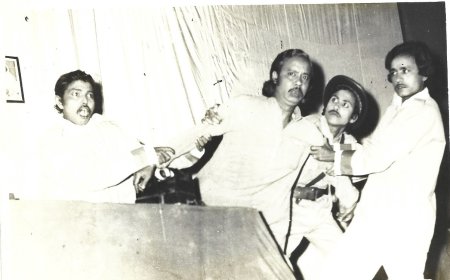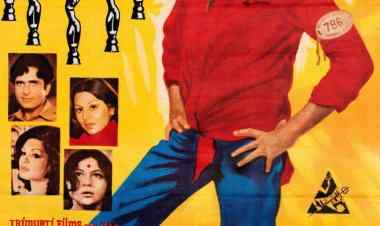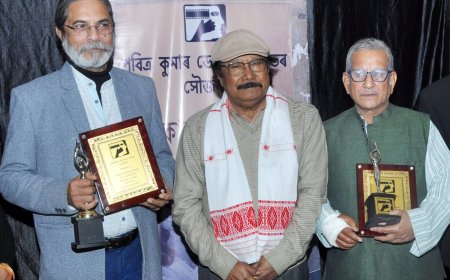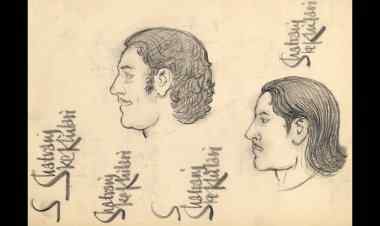FILM NOIR AND THRILLERS
Dr. Shoma A. Chatterji presented her research -oriented paper, "FILM NOIR AND THRILLERS" at the CONFERENCE ON RE-MEDIATING HOLLYWOOD/AMERICAN CINEMA", held at Vivekananda Hall, Jadavpur University.
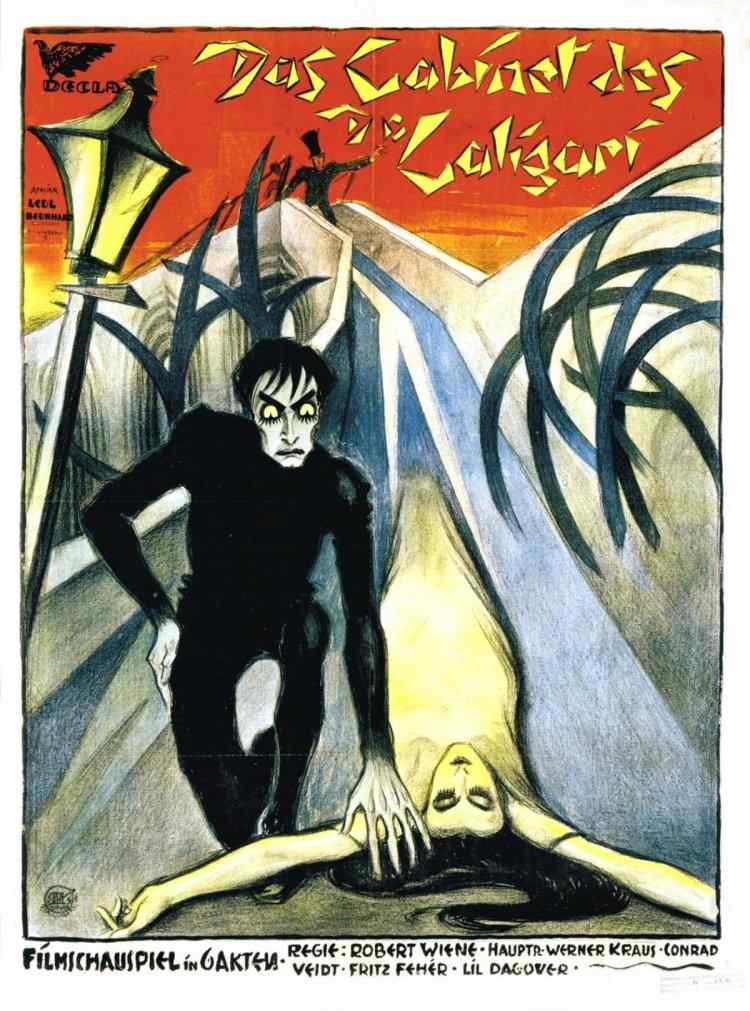
Introduction
The word “thriller” is derived from the word “thrill” which comes from the Middle English root meaning “to pierce.” This association relates to the aggressive, sadomasochistic nature of the thriller and also to its visceral, sensational side: a thrill is a sharp sensation as if one had been pierced or pricked by a sharp instrument. There is an intriguing similarity between the words thrill and thrall (slave, captive). These meanings come together in the word enthral which carries connotations of both being enslaved, captured and of being thrilled, spellbound.
Charles Derry in his book Thriller (1988) focuses entirely on the suspense thriller which, according to him, are crime films that lack a central, detective figure and that features a protagonist who is either an innocent victim of a non-professional criminal. He excludes the genres of the thriller film into detective films, police films, heist films, horror films, the psychological thriller, and spy films, not to leave out the stalker horror film, disaster films such as The Poseidon Adventure, science fiction films such as the first Dhoom film from Bollywood, and the sci-fi film like Dhoom 4 and Krrish. At the same time, one may recall that there is considerable overlapping between and among the thriller genres such as a film can combine several genres of the thriller to create significant suspense.
According to Chalres Derry, (The Suspense Thriller, 1988) those suspense thrillers are the best where the non-professional solver of crimes or the victim himself solves the crimes as these characters are placed in unfamiliar situations that enhance their vulnerability and to produce greater suspense. But one needs to also add that a thriller can also be inspired from real life crime happenings. A very successful thriller like Alfred Hitchcock’s Psycho or Billy Wilder’s Double Indemnity can turn into a cult film that becomes a serious subject of academic research though it is based on pure fiction. In fact, Alfred Hitchcock himself is a subject in most universities that offer film studies and film research within their course. If thrillers were ever considered to be derogatory to romance, drama, and historical period films, then filmmakers like Hitchcock invested the thriller with respect and dignity.
Film noir is a cinematic term used primarily to describe stylish Hollywood crime dramas, particularly those that emphasize cynical attitudes and sexual motivations. Hollywood's classical film noir period is generally regarded as extending from the early 1920s to the late 1950s. Film noir of this era is associated with a low-key, black-and-white visual style that has roots in German Expressionist cinematography. Many of the prototypical stories and much of the attitude of classic noir derive from the hardboiled school of crime fiction that emerged in the United States during the Great Depression.
Film noir is often characterised by a femme fatale who adds the erotic element to mystery and suspense in all forms. A femme fatale sometimes called a maneater or vamp, is a stock character of a mysterious and seductive woman whose charms ensnare her lovers, often leading them into compromising, dangerous, and deadly situations. She is an archetype of literature and art. Her ability to enchant, entice and hypnotize her victim with a spell was in the earliest stories seen as being literally supernatural; hence, the femme fatale today is still often described as having a power akin to an enchantress, seductress, vampire, witch, or demon, having power over men. An excellent example of the femme fatale is Marlyn Dietrich who perfected the art of enacting this kind of character in umpteen films. The femme fatale is an import from late 19th and 20th century opera. The femme fatale appeared in the film Body Heat (1981) which is said to have inspired the Bolllywood hit Jism which trapped Bipasha Basu in many horror-thriller-suspense films later on. Jism is an erotic thriller based on the 1981 Hollywood film Body Heat in which a woman convinces her lover, a small-town lawyer, to murder her rich husband. This film is stated to have been a contemporary remake of Double Indemnity.
In Jism, Sonia Khanna, wife of a very rich businessman, is a product of the camera’s careful construction of her body that makes the cinematic gaze as sensual, as erotic and as lucid as the Censors will allow. Her questionable background of having once been the nurse of her present husband’s sick wife who died mysteriously in a freak ‘accident’ raises rhetorical questions about her fitting into the normal and traditional course of ‘wifehood’. Her marriage to the much older and very rich widower is part of a larger project where ‘marriage’ is an agency, a means to a larger end. Jism is an erotic thriller where the eroticism plays the major role and the thriller element of murder is rendered subservient to the eroticism. The film was a major hit.
Thrillers in Bollywood Cinema
Has Bollywood cinema been influenced by Hollywood thrillers? In a way they have because the history of Bollywood is dotted with many thrillers some of which are original while some are adapted from Hollywood hit and also from South Korean films over time. But the tremendous changes that we come across in the Bollywoodisation of the original Hollywood films makes it quite tough to make out which Hollywood film it has been inspired by or adapted from.
What does “bollywoodisation” mean? Roughly speaking, it means the interweaving into the script and to the audiovisual narrative, elements of a typical Bollywood film such as the song-dance routine, action scenes, melodrama often extended to family melodrama, generous elements of co-incidence and so on. These elements dilute the experience of thrills in cinema as we know it from Hollywood films.
Let us take the example of the Hindi film Murder reportedly “copied” from the Bollywood erotic thriller Blow Hot Blow Cold. While the latter was a cutting edge murder mystery, the former was a crude imitation of the original where the climax was changed to suit the “box office” prospects of the film. The erotic content was emphasised over the thriller content which appeared only post-interval. The performances were quite poor as the actors were comparatively new and inexperienced and appeared to be camera conscious. But the producers and director seemed to have struck the right note because the film turned out to be a big box office hit.
Sometimes, there are gross misrepresentations in Bollywood about the original film the Hindi equivalent was based on. For example, the thumping box office hit Bees Saal Baad (1962) was touted in the media as a Hindi version of the film Hound of the Baskervilles. It was not at all that. It was a mixture of horror and thriller pretending to be a ghost film which again, it was not. In this film, Kumar (Biswajeet) returns to his abandoned ancestral manor where his father was mysteriously killed after he was rumoured to have been lured into the fields by the sound of anklets and crying of a woman who had been raped and killed by Kumar’s ancestor. Kumar falls for the local belle Radha (Waheeda Rehman). Ultimately, it is found that Radha’s guardian (Manmohan Krishan), father of the woman killed 20 years ago, had murdered Kumar’s father. There is no ghost at all so one might call it a murder mystery. One might call it film noir as there is a femme fatale in the form and shape of Radha who is forced to play the ghost.
Tanuja Chandra’s Sangharsh is said to have been inspired by Silence of the Lambs, which is so distanced from its Hollywood inspiration that it is nearly impossible to make any comparisons between Sangharsh and Silence of the Lambs which is an extremely sophisticated, cold and calculated psychological thriller while the former mixes a strange mishmash of a serial child killer whose killings are rooted in wrongly held ritual beliefs that make him criminally insane. Sunghursh is loud, crude and has an almost absurd romantic sub-plot intercutting the main plot and spoiling it all.
Some prominent Bollywood adaptations of Hollywood thrillers
1. The sole known Bollywood adaptation of a Hitchcock film is Aitbaar (1985) directed by Mukul S. Anand which was adapted from Hitchcock’s Dial M for Murder (1954). The film was also remade in Tamil and Malayalam. But the remake did not work well as a film because the director divided his attention between the music and songs on the one hand and the suspense and thrills on the other. The suspense handles very well but even then, the mehfils, the songs, the music and the former lover turning out to be a successful singer spoilt the very core of the thrills. This film is an ideal example of the complete Bollywoodisation of a Hollywood thriller.
2. Baazigar (1993) directed by Abbas-Mustaan was plagiarised from a Hollwyood thriller called A Kiss Before Dying (1991) which witnessed the slow and steady rise of two wonderful star-actors – Shahrukh Khan in a negative role and Kajol as both intended victim and self-appointed investigator. Though it held fort as a successful crime thriller, it also used a lot of songs and comedy. All that may be excused but what cannot be excused is the complete reversal of the character of the negative hero. In the original film and novel (Ira Levin), the killer is a cold-blooded, diabolical killer but Abbas-Mustaan have given the Bollywood killer a sad back story as if to justify his killings one after the other. Neither in the original nor in the Bollywood version was the killer a mentally deranged serial killer but the back story ruins it all and turns Baazigar into a melodramatic crime thriller.
3.Manorama, Six Feet Under (2007), co-written and directed by Navdeep Singh, acknowledges that the film was inspired by Roman Polanski’s Neo Noir cult classic Chinatown (1974). But the Indianization – I would not want to qualify it as Bollywoodisation – that needed to compromise a lot on the budget, the mounting, the props and even the actors – was not able to do justice to the adaptation. At the same time, the Bollywood version taken independently without drawing comparisons with Roman Polanski’s film, would stand very well on its own for its low-key treatment marred somewhat by the slow pace. Some of the actors did not do justice to their roles such as Raima Sen in an important role while the others did fine. But on the whole, the film seems insipid and dull juxtaposed against the electrically charged dynamism that the Polansky film had.
4. Samar Khan’s Shaurya (2008) is a clean Bollywood translation of A Few Good Men (1992) directed by Rob Reiner. There are hardly any differences except the relocation of the time and the context which has been rightly positioned to give the film and entirely Indian context. A Few Good Men is a combination of a thriller and a court room drama. The film revolves around the court-martial of two U.S. Marines charged with the murder of a fellow Marine and the tribulations of their lawyers as they prepare a case to defend their clients. Shaurya is about is about Captain Javed Khan's (Deepak Dobriyal) court martial trial for killing a fellow senior of the Rajputana Rifles. Major Siddhant Choudhary (Rahul Bose) portrays the defense lawyer, who is a very happy-go-lucky person with the least interest in fighting the case. Major Akaash Kapoor (Javed Jaafri) portrays a serious army lawyer and the best friend of Siddhant. The trial takes them to the tense and disturbed valleys of LOC and to Srinagar. The story revolves around Siddhant, who matures as a person during the trial as he converts himself into an individual who is trying to uncover the truth behind the entire tragic episode no matter the consequences. This is one of the most ideal adaptations of a Hollywood thriller in Bollywood though it did not fare well at the box office.
As one critic comments: “Matching up to Sorkin's machine-gun dialogue, Samar Khan's Shaurya was always going to fall short of its inspiration. However, putting aside the flaccid performances of Rahul Bose and Javed Jaffrey, the film is rescued by the quiet grace of Deepak Dobriyal and an explosive Kay Kay Menon. Menon manages the unthinkable by eclipsing Nicholson's stunning act.” This is true to a large extent, Dobriyal who has been falsely implicated in a murder case remains almost completely silent in the entire film juxtaposed wonderfully against Kay Kay Menon’s loudness as Rudra Pratap Singh replicating in his own style, the character portrayed by Jack Nicholson, the arrogant, powerful and violent senior who is actually responsible for nailing the Dobriyal character for a crime he did not commit.
5. Deewangee (2002) is a psychological thriller directed by Anees Bazmee and produced by Nitin Manmohan. The film is based on the 1996 Richard Gere movie Primal Fear which is a neo-noir crime thriller based on William Diehl's 1993 novel of the same name and directed by Gregory Hoblit. The film tells the story of a Chicago defence attorney who believes that his altar boy client is not guilty of murdering an influential Catholic Archbishop. But in the Hindi version, in order to fit himself into the character which is very young in the original film, Ajay Devgun who won almost all the Best Villain and Best Actor in a Negative Role awards for his performance, added age and girth to the character portrayed beautifully by Edward Norton in the original, thereby taking away the apparent naiveté of the character to a large extent. The older character is much less convincing than the younger one played by Norton and this functions negatively.
Akshaye Khanna duplicating Richard Gere as the defence lawyer, who is convinced that his client is innocent of having killed a priest in the Church, has fulfilled his role very well indeed. Deewangee had nine songs in the film that also took the edge off the suspense and the thrills. That said, Deewangee, though a box office success cannot hold a candle to the original it was inspired by. It lacks the repeat value of the original specially the electrifying climax where the attorney is left looking like a fool.
6. Rajkumar Gupta's gripping thriller Aamir (2005) was based on a Filipino-American film called Cavite where an expatriate visiting his family is told his family is being held ransom. And they will be killed unless he obeys a series of instructions on the phone. Rajeev Khandelwal is brilliant as the protagonist in the Bollywood version of the story. Aamir contains a brilliant soundtrack by Amit Trivedi. Cavite, released in 2005, has exactly the same narration as we have seen in Aamir. The story revolves around a man flying back to his home country who is forced to participate in a terrorist plot and is threatened, if he doesn't comply with certain demands.
7. Kamal Amrohi's Mahal (1949) produced by Bombay Talkies reflects the influence of German Expressionism, especially the Cabinet of Dr. Caligari. Mahal, the stunning play of darkness and light, flickering shadows in stairwells is suggestive of the link between the real and the surreal world, of troubled relationships hinged on obsession and suicide. Mahal is an example of a film where the story is not an adaptation from any Hollywood or European film but in terms of technique and methodology, it was strongly inspired by German Expressionism which also inspired Hollywood filmmakers to a large extent during the late 1930s and 1940s. A very stylish, atmospheric, noir ghost love story that clearly reflects the influence of German Expressionism on Indian cinema, Mahal was shot by German cinematographer Josef Wirsching.
In Mahal, Hari Shankar (Ashok Kumar) comes to live in an old mansion, and is surprised to discover that he resembles the portrait of the house’s late previous owner. The former owner and his lover Kamini had died tragically, with the owner promising her he will be reborn to reunite with her some day. Later, Hari falls in love with a beautiful woman (Madhubala), seemingly a ghost, and some melodramatic twists later, it seems he may be the reincarnation. Madhubala is gorgeous, and her song “Aayega aayega aayega aanewala” (the one who is to return, will return) remains popular in India even today. A box-office hit, Mahal inspired several ghost/reincarnation love stories, including Madhumati, Karz and Om Shanti Om.
The Cabinet of Dr Caligari (Das Cabinet des Dr Caligari), Robert Wiene, Germany, (1919) is widely considered the first, true horror film. Emerging from the devastations of World War I, the film recounts the story of a crazy fairground performer, Dr Caligari, and a sleepwalker, Cesare, who he is suspected of hypnotizing and directing to commit murders. The film marked a turning point in the history of world cinema by using extraordinarily inventive stylized sets and visual distortions. The landscape is all crooked-- with tilting walls and diagonal staircases--and so are its characters: rather than capture reality, it conjured a psychological landscape of horror. It gave rise to the horror genre, and its camera angles, lighting and drama deeply influenced film noir. In his book From Caligari to Hitler, Siegfried Kracauer suggests that Caligari was Hitler and the German people were sleepwalkers under his spell.
Conclusion
There is a mixing of genres of the horror film, the ghost film and the murder mystery in both Bollywood and Hollywood cinema. There are hardly any pure courtroom dramas except rare exceptions like B.R. Chopra’s Kanoon which combined murder with courtroom drama and as far as common knowledge goes, was not a Hollywood adaptation. The recent Ittefaq is a police thriller that stems from a gruesome murder.
In fact, Bollywood originals not adapted from Hollywood or any other cinema have been quite successful in their own genres, almost always a mixture of several genres. B.T. Chopra’s Ittefaq and the recent Ittefaq (2017), films like Woh Kaun Thi directed by Raj Khosla, Bimal Roy’s Madhumati which was a very good mix of a ghost, a reincarnation-love story and a murder have been both critically and commercially successful films though they were completely mainstream filled with romance, song-dance numbers, sharply fleshed out villains and so on. With Bollywood inspirations/adaptations, the success rate has been like a gamble – some very good and some not good at all.
The issue with Bollywood “remakes” of Hollywood thrillers lies in that Bollywood filmmakers copy or improvise upon or Indianise the narrative but not the technique which is no less important than plot, story, and characterisation in thrillers never mind to which genre they belong. There is of course the drawback since we shifted from Black-and-White to colour as we all know that Black-and-White cinematography and light effects in thrillers works much better than when they are shot in colour. The magic of films like Mahal and Madhumati are illustrations in point. Or, if we were to take Hitchcock’s films as examples, we may place Psycho next to North by Northwest, or, Witness for the Prosecution – mainly a courtroom drama blended with a murder mystery, beside Vertigo. Bollywood directors do not care to adapt the technique used by Hollywood thrillers and remain limited by the plot and the storyline.
A few exceptions like Sujoy Ghosh’s Kahaani (2012) which is almost a carbon copy of Taking Lives (2004), especially the climax, is an example where there are scenes that are frame-to-frame copies from the original Hollywood film. But the film became a milestone hit with the Indian audience. His recent film Badla is also an inspired Hindi version of a Spanish original but both the original and the Bollywood copy are not up to the standard established by the pioneers in the thriller and film noir genre. Ghosh made minor changes in the remake but this does not give Badla an identity of its own and it remains just a “copy” of a bad film filled with glitches, co-incidences and lack of logic.
At the same time, Bollywood directors have not ventured into their own versions of the works of Alfred Hitchcock. Or, any of the Orson Welles’ classics such as Citizen Kane (1941), a cult film. Ciizen Kane cannot really be clubbed in the thriller genre but the heightening suspense the film creates and sustains till the anti-climactic end can perhaps be boxed as a suspense-filled thriller where the victimizer and the victim is visited upon the same character – Citizen Kane himself enriched by the wonderful portrayal by Welles. The film was released on Blu-ray on September 13, 2011, for a special 70th-anniversary edition.
No Bollywood director to our knowledge has touched Welles’ other thrillers such as Touch of Evil (1958) or The Lady From Shanghai (1947) which are considered cult film noir today. Unlike Hitchcock, Welles did not confine himself to thrillers or film noir and made classic films such as The Magnificent Ambersons and Shakespearean classics, documentaries, radio programmes and television serials. Hitchcock honed his skills, his creative energy and intelligence to such a great extent that one wonders if world cinema has been able to produce a Hitchcock of its own.
***
What's Your Reaction?









































